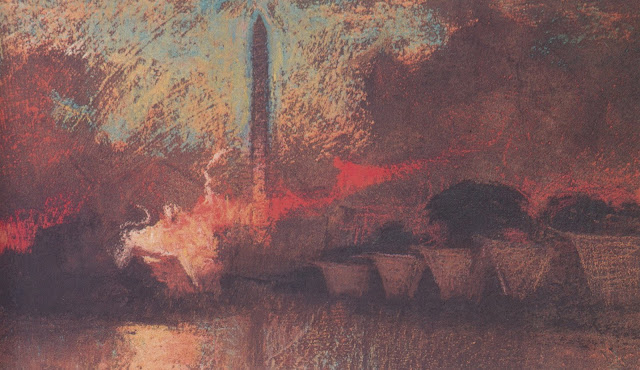Tuesday, February 23, 2021
ONE LOVELY DRAWING, part 65
Friday, February 19, 2021
NEW BOOK ABOUT T.S. SULLIVANT
After a delay of 100 years we can finally celebrate the arrival of a compilation of work by the brilliant T.S. Sullivant.
Sullivant was part of that blessed generation of ink worshippers that included A. B. Frost, Heinrich Kley and Charles Dana Gibson, and he was as good as any of them.
At 400 pages, this book provides a large, juicy selection of Sullivant's work. Here Sullivant shows us how the very first cartoonist got his inspiration:
What a wealth of talent and imagination are on display in the pictures and essays of this book.It takes a second to figure out what's going on.... There's an extra beat of discovery as the viewer is compelled to pause a moment and look a little harder to earn the reward of recognition. A lesser exaggeration would offer a much quicker "read" but Sullivant will have none of that. In an age where every image on every page or online platform competes with a trillion others to catch even the most fleeting of glances, I find great pleasure in the drawings of an artist who trusted his skill enough to know that the viewer would accord his work the extra scrutiny it demanded.
Sunday, February 14, 2021
Friday, February 05, 2021
THE JOURNALIST ILLUSTRATORS: HARVEY DINNERSTEIN
Harvey Dinnerstein had some interesting things to say about the relationship between art and journalistic illustration.
Like his friend Burt Silverman, Dinnerstein was a "fine" artist who earned money on the side drawing reportorial assignments for news magazines. Like Silverman, Dinnerstein specialized in portraits:
 |
| Detail from Parade |
 |
| Detail from Parade |
A major element in developing a pictorial image is the integration of particular information with a generalized concept. This is a most difficult question to resolve. If the artist is only concerned with incidental information the image will lack significant form. However, if the generalization is a mannered abstraction, it will become an empty stylization that will lack the organic quality of life.
A decade later, in the wake of the assassination of King, and the escalation of American involvement in Vietnam, a protest movement containing many different elements swept across the country. I was commissioned by Esquire magazine to cover these events, and in depicting the demonstrations of the sixties I tried to get beyond the incidental nature of various events, and grasp a larger context of the movement and its implications.
 |
| Kathe Kollwitz |
There were amazing events in that period.... Candlelight procession at night, outside of St. Patrick's Cathedral.... Moratorium vigil, that presents aspecys of ritual and reminds me of paintings by Georges de La Tour.... Fort Dix, New Jersey: A protest march onto the military post, past barbed wire barricade, calling on G.I.'s to refuse to obey the orders of their officers. The march is dispersed with gas.... Chicago: An explosion of terrorist violence leaves a tail of shattered glass along the elegant streets of the city's gold coast.... after the killings of students at Jackson and Kent State there is a massive demonstration in Washington.... Communication seems impossible. Suddenly a group of demonstrators remove their clothes and charge nude into the reflecting pool before the Lincoln Memorial. As they are joined by others , an old black woman on the embankment sings the spiritual, "Wade in the Water." It happened! I saw it, and though I did not comprehend everything that was going on, these were remarkable events....
 |
| Burning shack in the Poor People's Encampment near the Washington monument |
 |
| Dinnerstein conflates a death at a riot with his memory of a Roman sarcophagus |
 |
| Protestors at St. Patrick's Cathedral remind Dinnerstein of a de La Tour painting |
Monday, February 01, 2021
THE JOURNALIST ILLUSTRATORS: PAUL HOGARTH
The best journalistic illustrations seem to combine an enthusiasm for facts, a love of drawing, and a third element-- a personality or character which presents the subject matter in an interesting manner that a photograph could not.
Noted illustrator Paul Hogarth (1917-2001) described the third element this way: "The problem is how to make an image compelling, even in an aesthetic way – not just to sit down and make a record."
 |
| Hogarth's view of a Las Vegas casino |
 |
| Detail |
Hogarth populated his travelogues with light, whimsical drawings of local people:
Hogarth teamed with many of the leading writers of his day to prepare his reports from around the world. He illustrated Alistair Cooke's writings about America, Robert Graves' writings about Majorca, Laurence Durrell's writings about Corfu, Brendan Behan's writings about Ireland. Most famously, his long partnership with Graham Greene took Hogarth to more than 20 countries.



























